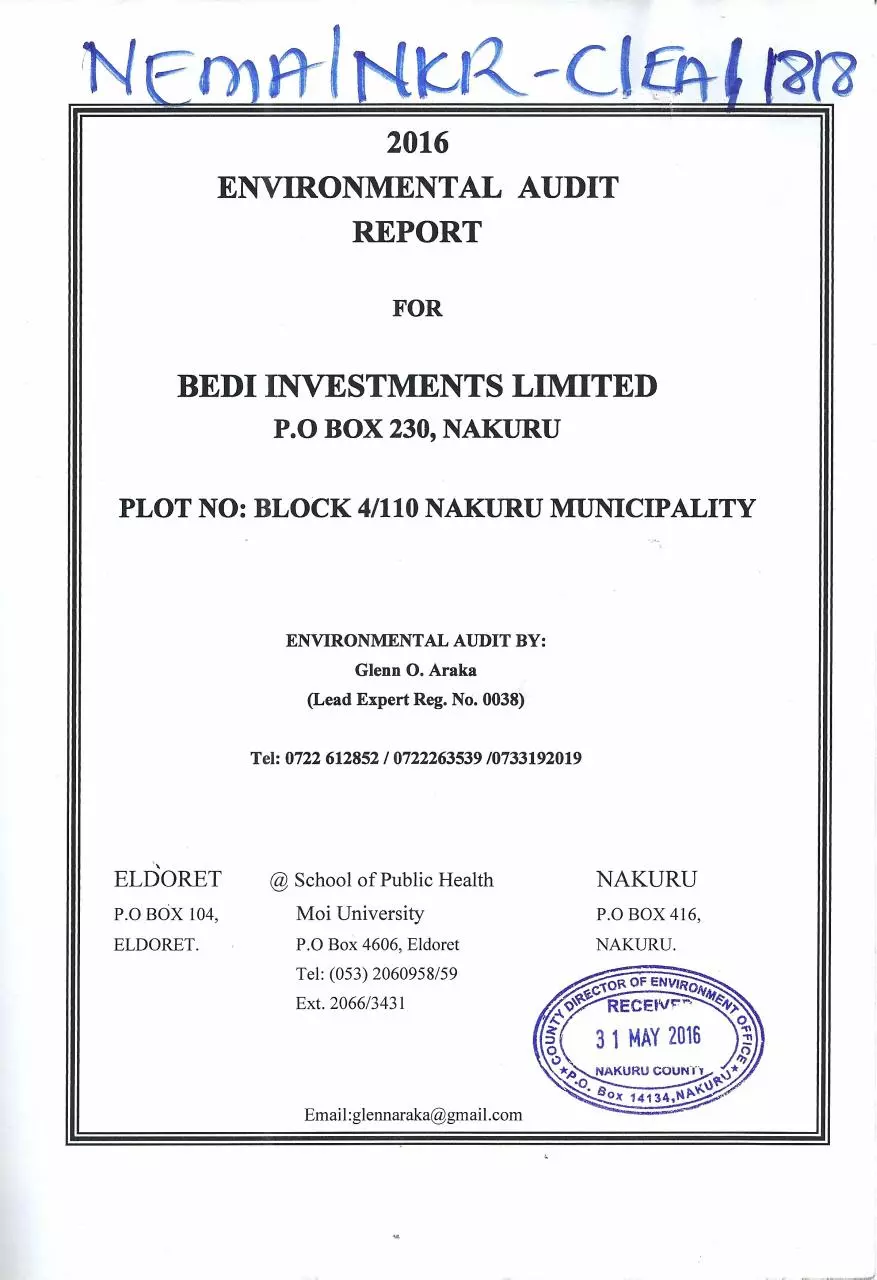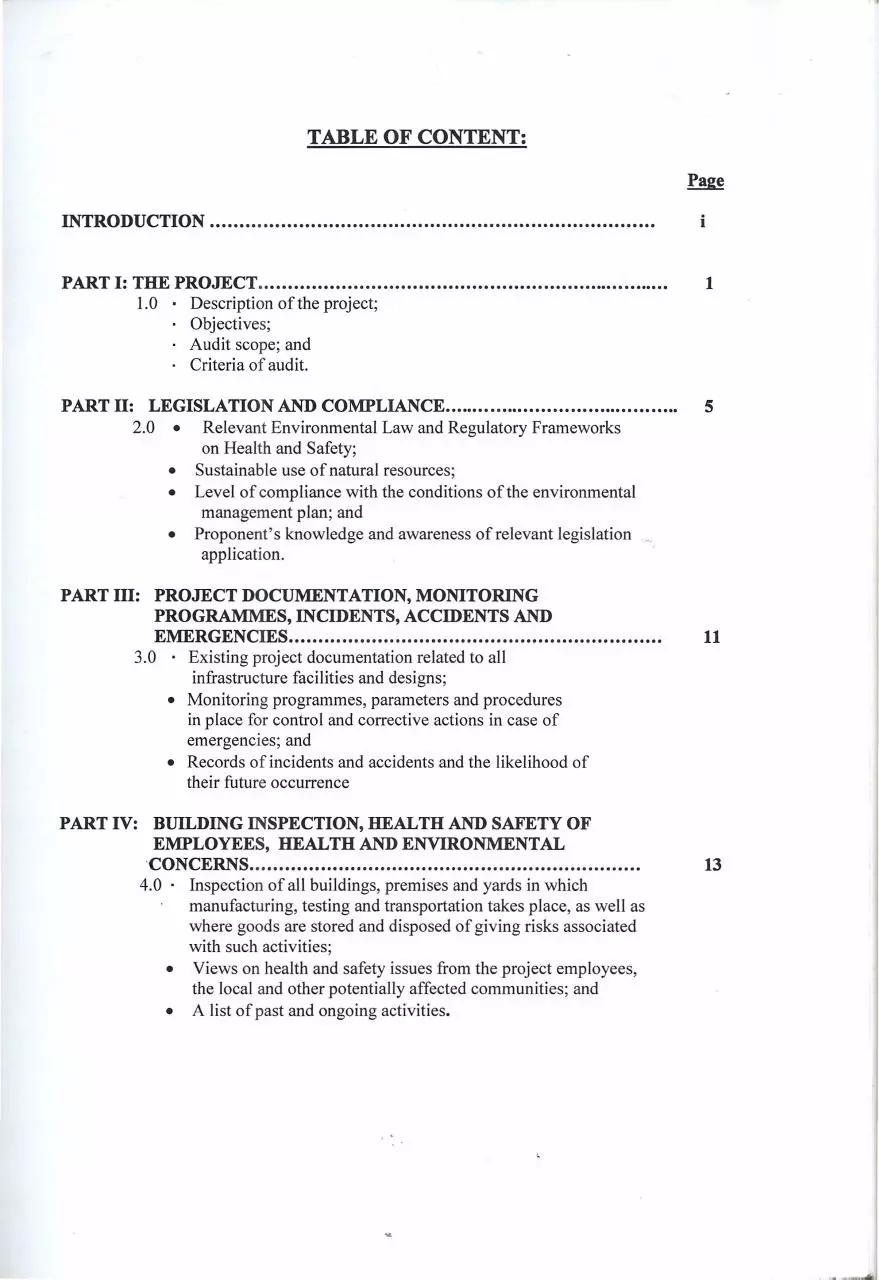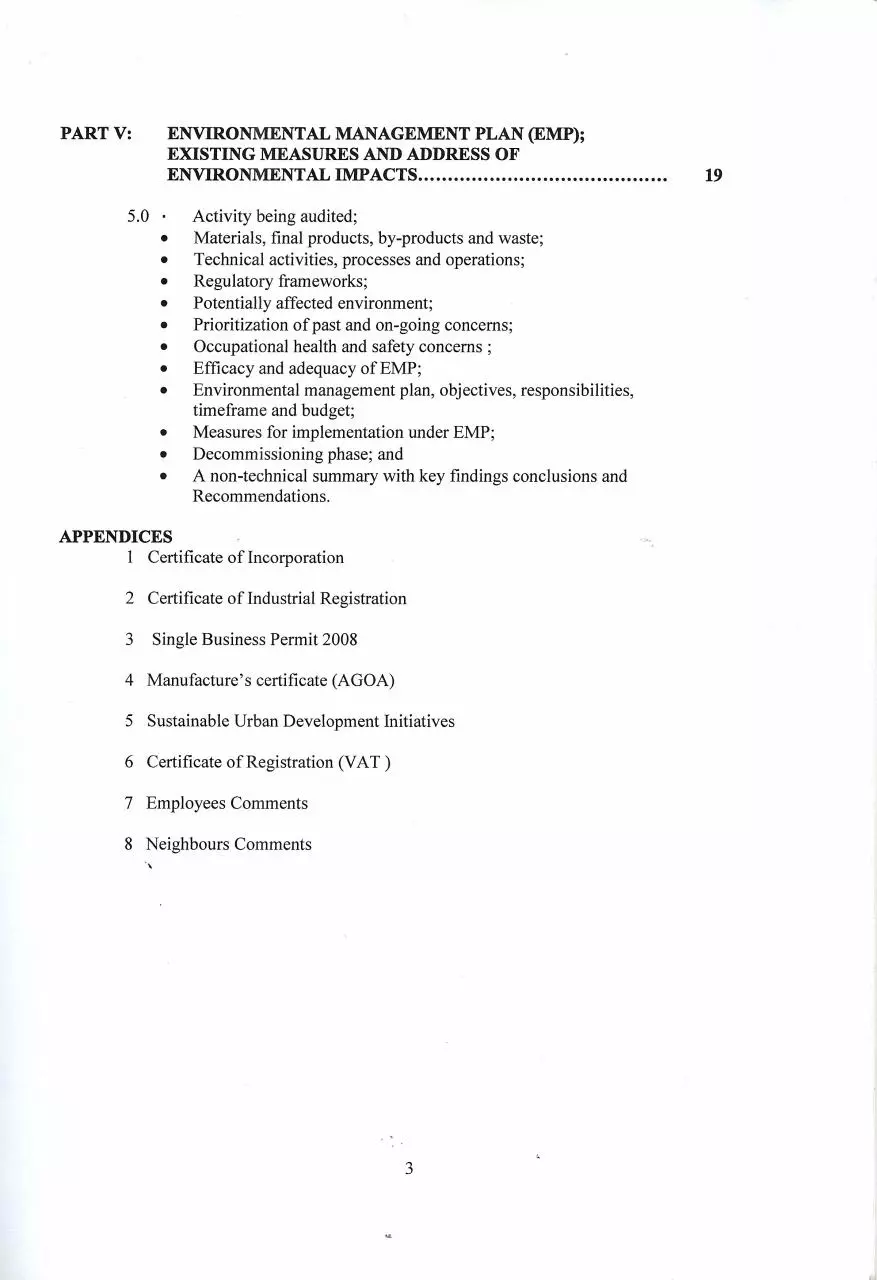NEMA Report (PDF)
File information
Author: USER
This PDF 1.4 document has been generated by DPE Build 5656, and has been sent on pdf-archive.com on 09/08/2016 at 14:00, from IP address 197.248.x.x.
The current document download page has been viewed 450 times.
File size: 25.95 MB (40 pages).
Privacy: public file





File preview
2016
ENVIRONMENTAL
AUDIT
REPORT
FOR
BEDI INVESTMENTS LIMITED
P.o BOX 230, NAKURU
PLOT NO: BLOCK 4/110NAKURU MUNICIPALITY
ENVIRONMENTAL AUDIT BY:
Glenn O. Araka
(Lead Expert Reg. No. 0038)
Tel: 0722612852/0722263539/0733192019
",
ELDORET
@ School of Public Health
NAKURU
P.O BOX 104,
Moi University
P.O BOX 416,
ELDORET.
P.o
NAKURD.
Box 4606, Eldoret
Tel: (053) 2060958/59
Ext. 2066/3431
Email: glennaraka@gmail.com
TABLE OF CONTENT:
INTRODUCTION...
i
PART I: THE PROJECT........................................................
1.0
Description of the project;
Objectives;
Audit scope; and
Criteria of audit.
1
PART II: LEGISLATION AND COMPLIANCE.........................................
2.0 • Relevant Environmental Law and Regulatory Frameworks
on Health and Safety;
• Sustainable use of natural resources;
• Level of compliance with the conditions of the environmental
management plan; and
• Proponent's knowledge and awareness of relevant legislation
application.
5
PART ill: PROJECT DOCUMENTATION, MONITORING
PROGRAMMES, INCIDENTS, ACCIDENTS AND
EMERGENCIES...
3.0
Existing project documentation related to all
infrastructure facilities and designs;
• Monitoring programmes, parameters and procedures
in place for control and corrective actions in case of
emergencies; and
• Records of incidents and accidents and the likelihood of
their future occurrence
PART IV: BUILDING INSPECTION, HEALTH AND SAFETY OF
EMPLOYEES, HEALTH AND ENVIRONMENTAL
'CONCERNS...
4.0· Inspection of all buildings, premises and yards in which
manufacturing, testing and transportation takes place, as well as
where goods are stored and disposed of giving risks associated
with such activities;
• Views on health and safety issues from the project employees,
the local and other potentially affected communities; and
• A list of past and ongoing activities.
11
13
PART V:
ENVIRONMENTAL MANAGEMENT PLAN (EMP);
EXISTING MEASURES AND ADDRESS OF
ENVIRONMENTAL IMPACTS..........................................
5.0
•
•
•
•
•
•
•
•
•
•
•
Activity being audited;
Materials, final products, by-products and waste;
Technical activities, processes and operations;
Regulatory frameworks;
Potentially affected environment;
Prioritization of past and on-going concerns;
Occupational health and safety concerns;
Efficacy and adequacy of EMP;
Environmental management plan, objectives, responsibilities,
timeframe and budget;
Measures for implementation under EMP;
Decommissioning phase; and
A non-technical summary with key findings conclusions and
Recommendations.
APPENDICES
1 Certificate of Incorporation
2 Certificate of Industrial Registration
3
Single Business Permit 2008
4 Manufacture's certificate (AGOA)
5 Sustainable Urban Development Initiatives
6 Certificate of Registration (VAT)
7 Employees Comments
8 Neighbours Comments
3
19
INTRODUCTION
1.0 DEFINATION: Two impressions are used in respect of Environmental Management. These
are Environmental Impact Assessment (EIA) and Environmental Audit (EA).
1.0.1
Environmental Impact Assessment
The EIA sometimes known as environmental effects statements
(EESs), the environmental statement (ES) or as the environmental
impact statements (EISs), depending upon country, is a document
prepared by a proponent, describing a proposed development or
activity (or plan, or programme) and disclosing the possible, probable
or certain effects of that proposal on the environment.
1.0.2
Environmental Audit
EA, sometimes known as facility environmental audit (FEA) is a basic
in plant management tool comprising of a systematic, documented,
periodic and objective evaluation of how well facility environmental
management systems and equipment are performing. The aim of the
audit is to facilitate effective control of environmental practices and to
enable the company to access compliance with company policies,
including meeting regulatory requirements.
1.1 MAJOR DEVELOPMENTS
LIKELY TO IMPACT ON
THE ENVIRON MENT
(i) Land use and Transformation
Urbanization:
industrial
and
agricultural
development,
transportation systems, energy and power transmission, bush
burning.
(ii) Resource Extraction
Mining, drilling, quarrying, saw-milling and logging.
Hunting and fishing, water treatment, storage and disposal.
(iii) Resources Conservation and Renewal
Afforestation: wildlife management.
(iv) Agricultural Activities
Clearing of bush; fertilization,
discharge.
soil
conservation;
effectual
(v) Transportation
Roads, railways, airports and habours; vehicles, aircrafts and
shipping.
vi). Energy
Dams and man-made ideas, power lines, pylons and oil pipes,
power stations; fuel, wood and charcoal processing; petrol service
stations.
vii). Treatment
Pest control (pesticides), weed and bush control (herbicides) and
arbonicides) to the internal and external environment.
(viii) Recreation
Tourism and resort development, park reserves and hunting areas.
1.2 DEVELOPMENT
ACTION UNDER
AUDIT:
Focused on the operations of BIL in relation to the biological,
economic,
social and physical
(BESP)
environments
this
environmental auditing broadly is intended to:
1.3 WHY AUDIT?
1.3.1
1.3.2
1.3.3
1.3.4
1.3.5
1.3.6
1.3.7
1.3.8
1.3.9
1.3.10
\
Development ACTION under environmental audit is Bedi Investments
Limited (BIL), a textile industry. This falls under 1.1.(i) above.
1.3.11
1.3.12
1.3.13
establish the efficiency of environmental management system III
operation;
determine and document compliance status;
improve overall environmental performance at the operational facility;
increase the overall level of environmental awareness;
improve the environmental risk management systems;
develop a basis for optimizing environmental resources;
project positive concerns about environmental effect and commitment
to take steps necessary to correct identified problems;
avoid substantial fort liability arising from personal injury;
avoid the surprise disruption and unplanned cost of sudden
enforcement actions;
develop better relations with government agencies through the
presence of an affirmative programme designed to find and correct
problems before they become dangers;
build closer links with community and government not only to
minimize the change of environmental conflict, such as enforced shut
downs and product funs, but also help better the image of the company
and industry in general, in terms of the positive role and contribution
they provide;
realize savings through process changes to reduce the amount of raw
materials needed or create less pollution to be civil criminal liability
under the current environmental law and regulation; and
present the existing and the predicted impacts, mitigation and options
to decision makers.
11
1.4. TERMS OF
REFERENCE:
Under section 35 of the Legal Notice No. 101 (the Environmental
Impact Assessment and Audit Regulations, 2003) of the Environmental
Management and Coordination Act, 1999 the following are the contents of
an environmental audit; which for this purpose will serve as terms of
reference:
1.4.1
1.4.2
1.4.3
1.4.4
1.4.5
1.4.6
1.4.7
1.4.8
1.4.9
1.4.10
1.4.11
1.5 COMPILED
ENVIRONMENTAL
AUDIT REPORT
1.5.1
1.5.2
\
1.5.3
1.5.4
1.5.5
1.5.6
1.5.7
1.5.8
1.5.9
1.5.10
1.5.11
Terms of Reference
Description of the project;
Objective, scope and criteria of the audit;
Relevant environmental law and regulatory frameworks on health and
safety; sustainable use of natural resources vis national and
international standards;
Level of conditions compliance;
Proponent's
knowledge and awareness/responsibility
for the
application of relevant legislation;
Review project documentation; infrastructure facilities and designs;
Examine monitoring programmes, parameters, strategies for control
corrective actions for emergencies;
Examine records of incidents and accidents and their future
occurrences;
Inspection of all buildings, premises and yards indicating possible
risks;
Views on health and safety from project employees, local and
communities; and
A list of health and environmental concerns of past and on-going
activities.
Section 36(2) of the same regulations requires that an
environmental audit report compiled under these regulations shall
contain (also included as terms of reference):
Type of activity being audited;
Materials, non-manufactured final products, by-products and waste
generated;
Description of all technical activities, processes and operations;
Protective legislation on ecological and socio-economic matters;
Affected environment on ecological and socio economic matters;
Prioritization of all past and ongoing concerns of the project;
Environmental and occupational health and safety concerns of the
project;
Efficacy and adequacy of environmental management plan;
Recommendations for their corrective activities, their cost, timetable
and mechanism for implementation;
Measures taken to ensure implementation
IS
of acceptable
environmental standards; and
Summary outlining the key findings, conclusions and
recommendations of the auditor.
III
ONE
PART I: THE PROJECT
1.0
•
•
•
•
Description
Objective
Audit scope
Criteria of audit; and
•
Methodology
1.0.1
DESCRIPTION OF THE PROJECT:
(i)
PROJECT TITLE: BEDI INVESTMENTS LTD (BIL)
(ii)
ADDRESS:
P.O. BOX 230, NAKURU
(iii)
PHYSICAL
ADDRESS:
BLOCK 4/110, LOWER FACTORY ROAD
NAKURU MUNICIPALITY.
(iv)
PROJECT TYPE:
TEXTILE INDUSTRY
(v)
SUBJECT:
ENVIRONMENTAL AUDIT
(vi)
LOCATION
(vii)
(a)
Road:
(b)
Surroundings:
Lower Factory
North:
Londra Ltd (a textile industry), Loncom House,
Kufanya Road, George Morara Road.
South:
Kenya Industrial Estates (KIE) Shades.
East:
Lower Factory Road, Garden Hotel, Crane Lodge,
West Road, Hotel Water Buck, Valley Hospital.
Further East: West Road, Hotel Falcon, Court Road,
Provincial Police Offices, District Commissioner's
Offices, Electoral Commission of Kenya and open air
garages along Government Road.
West:
Kalima Road, Kenya Police Driving Test Office,
Police Workshop.
1
South-east:
Oginga Odinga Avenue.
North-east:
Associated Auto Centre.
North-west:
Uni- Truck Ltd, Bhoghals Garage.
West-south:
Kenya Industrial Estates Shades
(vii) Registration and Business
(a)
(b)
Registration
The business is a legal enterprise registered as a limited company
under the Companies Act Cap 486 of the laws of Kenya of which a
Certificate of Incorporation was issued. (Appendix 1)
Also in recognition of existence the project was registered under the
Industrial Registration Act, 1987(No. 14 Of 1987) by the registrar of
industries for which a certificate was issued.{ Appendix 2)
Business
BIL undertakes a business of textile processing i.e. Blending,
Blowing, Spinning, Weaving, Packing, Cutting; Tailoring and
Textile finishing under which the following licences are granted:
• County Government approval.
The project also operates with the approval of Nakuru County
Government (NCG) under which area of jurisdiction the project
falls and for this reason a Single Business Permit is granted
annually. (Appendix 3)
1.1 OBJECTIVES
The main objectives of this environmental audit are:1.
To environmentally audit BIL textile industry in respect of its buildings,
premises, yards, processes, products and wastes.
11.
To list existing and probable impacts from the activities of the project.
111.
To present the impacts, their mitigation and options to the decision makers.
1.2 AUDIT SCOPE
The audit scope broadly focuses on two major areas:
i. Internal Environment
• Water Supply
• Evidence of dust or particulate matter
• Condition of natural ventilation and lighting
• Personal protective equipment (PPE)
2
•
•
•
•
•
•
•
•
•
•
•
•
•
Condition of the building
Drainage system
Pre-treatment units
Fire fighting equipment and means of escape during fire outbreaks
Noise emission
Storage facilities
Sanitary accommodation
Electric safety
Health of the workers
Risk management
Work space
Thermal environment
Energy use
1.2.1 External Environment
• Building status.
• Pre-treatment units.
• Solid waste management.
• Health of the neighbours.
• "Sewerage system.
• Emergency services.
• Infrastructure services.
• Drainage system.
• Air, land and water pollution.
1.3
IMPACT TO BE
CONSIDERED:
Those that:
1.3.1
Negatively impact the environment
1.3.2
Positively impact the environment
To be noted: that the basic principle is that the more a socio-economic
system is developed to comply with natural law, the more stable and
compatible that system will be with its surrounding environment; and the
primary impact of a project can be transformed into a secondary impact to
affect the environment elsewhere.
1.4
CRITERIA OF
THE AUDIT:
1.4.1
Apply NEMA guidelines as pertains to environmental audit.
1.4.2
Compare the existing standards of the project with those of national and
international.
3
Download NEMA Report
NEMA Report.pdf (PDF, 25.95 MB)
Download PDF
Share this file on social networks
Link to this page
Permanent link
Use the permanent link to the download page to share your document on Facebook, Twitter, LinkedIn, or directly with a contact by e-Mail, Messenger, Whatsapp, Line..
Short link
Use the short link to share your document on Twitter or by text message (SMS)
HTML Code
Copy the following HTML code to share your document on a Website or Blog
QR Code to this page

This file has been shared publicly by a user of PDF Archive.
Document ID: 0000411946.